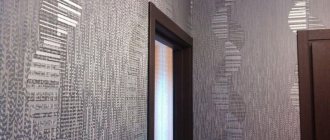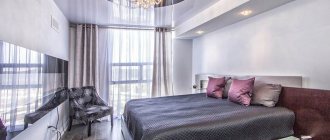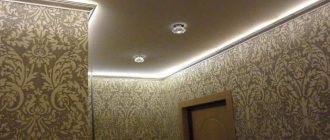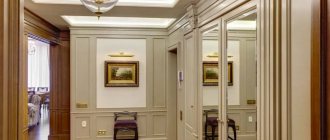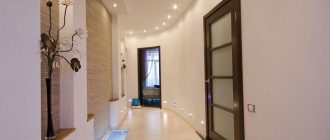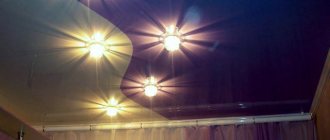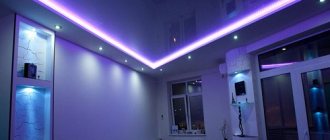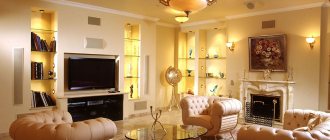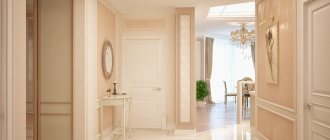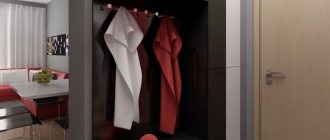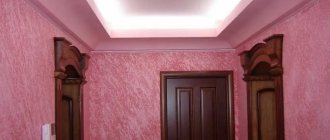The first impression of a house is formed from the threshold, which is why the appearance of the corridor is so important. In addition to the stylish and cozy decoration, it is necessary to think about the lighting of the ceiling in the hallway. After all, not only the perception of the apartment by guests, but also the convenience of getting ready in the morning depends on how well it is organized. Let us consider in detail the existing types of lighting fixtures, options for their location, as well as the possibilities of zoning and adjusting space with the help of light.
Which chandelier to choose for the corridor
Depending on the type of design, chandeliers can be suspended or overhead (or ceiling-mounted). The first ones are elongated in the vertical direction and due to this they “eat up” the height of the ceiling. As a rule, a hook is used for fastening.
Such chandeliers can be quite massive, with several arms, decorative inserts, etc. Such options are appropriate only in large halls. Pendant lamps of a more modest size are suitable for a high, spacious hallway, which are more often found in private homes than in standard apartments.
Overhead chandeliers have a small height, mainly occupying horizontal space. They are suitable for low rooms and are mounted on a bar.
When choosing the type of construction, it is necessary to take into account the distance from the bottom edge of the lampshades to the floor. It will be comfortable to walk along the corridor if it is about 2.2-2.3 meters.
Chandeliers also differ in the level of illumination, which depends on the number of horns, the type of bulbs and their power. The number of shades may vary. For a corridor, 2-3 are usually enough. It is better when the light source is closed so that it does not hit the eyes. If the horns are pointing down, you should choose frosted light bulbs.
The overall level of illumination should be sufficient to clearly see your reflection in the mirror, but not blind your eyes, this is harmful to your vision.
The level of illumination is measured in lux - lumens (unit of luminous flux) per square meter. According to SNiPs, the minimum value for corridors and hallways is 50 Lux. But it is desirable that there is not a big contrast with the rooms that are nearby. Information on the level of illumination and lamp power, as well as recommendations on the volume of the room, can be read on the packaging of the chandelier.
By type of light bulb they are divided into:
- incandescent lamps (the traditional version, they get very hot, which is why they use no more than 60 W with a suspended ceiling);
- halogen (here the limitation is even stricter - 35-40 W);
- energy-saving (consume a lot of energy when turned on and do not immediately flare up, therefore they are effective only with constant operation);
- LED (the most economical option, which is most often used with suspended ceilings).
The style and color of the device is selected to match the interior of the hallway. The designs and materials are varied. They use chrome-plated and brushed metals, glass, crystal, plastic, fabric, etc.
What lamps are best for the hallway
Some recommend choosing maximum illumination, while others believe that moderate light is sufficient in the hallway. According to SNiP standards, the illumination of the hall and corridor should be at the level of 50 Lux.
1 lx = 1 lm/m2
To make it easier for you to imagine, we offer the following comparison:
250lm = 20W incandescent lamp = 5-7W fluorescent lamp = 4-5W LED lamp.
The standards indicate a preferred threshold below which performance should not fall. Lighting is one of the factors that can have various psychological effects on a person. For example, a lack of light can be depressing, while too much light can be annoying and even provoke aggressive behavior.
Another factor that requires attention: since we are putting clothes and makeup in order in the hallway, we need the color perception to be consistent with natural daylight. A typical example is women purchasing lipstick. Bright, cool white light makes colors appear dull and skin pale. Once on the street, women often discover that in reality the shade of lipstick is not the same as they saw it when the window was illuminated.
Spotlights and spotlights in the hallway
Spotlights are used both in addition to the chandelier and separately. By variety they are divided into:
- built-in (the housing is located behind a suspended or suspended ceiling);
- overhead (located on the surface, due to which they have a larger lighting angle).
Spots, unlike lamps, are equipped with a rotating mechanism. To change the angle of inclination, a hinge hidden in the body or a tire is used. Thanks to this, it becomes possible to direct the light flux to a specific point. Spots can be single or combined into groups - on a common platform or cable.
An important feature of dot products is their narrow focus. When used as main lighting, you need to install several devices at a short distance from each other (0.5-1 meter). In the corridor they are placed along a line, flat or wavy. For a square-shaped hallway, installation in the center and in the corners or along the perimeter is suitable.
Another option that can replace a chandelier is several spots united by a common base. An elongated shape is suitable for a long corridor, and a round shape is suitable for a hallway resembling a square.
When combined with a chandelier, the lamps are placed in areas that require additional lighting. This is a mirror, a wardrobe, a clothes hanger, a shelf for small items, etc.
Recommendations for luminaire placement patterns
How to correctly position light sources so that hallway lighting is as effective as possible? The original route of the electrical wiring, its condition, as well as your ability to design new routes for laying the electrical cable will be important.
- Central or main lighting. The lamp is located in the geometric center of the hallway - this is the point at the intersection of the ceiling diagonals. In this position, the lighting intensity is most advantageous. Additional light sources are located around the perimeter, along the walls.
- If the corridor is elongated and narrow, then it is worth placing several ceiling lights along the larger central axis.
- Wall lamps and sconces are mounted along the wall at a level of 1.8-2 meters. They should be slightly above eye level so as not to dazzle, but not too high, otherwise specific shadows will fall on the face, preventing you from adequately assessing your appearance.
- Local lighting: designed to illuminate specific areas. For example, the perimeter of a mirror, a poster on the wall, closet shelves. High-quality local lighting allows you to solve the problem without using the main light.
- Decorative LED lighting: this includes LED strips that can be used to illuminate the ceiling, baseboards, and doorways. Also now used for decorative lighting of rooms are garlands and LED grids, which are mounted on the wall as a light panel.
Manufacturers offer a wide range of lamps in various styles. When choosing, it is important to consider the height of the ceiling and the total intensity of lighting that you really need.
How to use lighting to expand a narrow corridor
There are several options here. The first involves the use of spots. They are directed towards the walls, thus visually increasing the space between them.
The second option is to build in lamps and arrange them not in a straight line, but in an arc. This technique visually expands the ceiling surface. These methods can be combined with each other.
Another method is to divide the corridor into zones, each of which is illuminated separately. Depending on the length, 2-3 sections are obtained. For example, space near the door for storing things (in the closet area) and moving things around. In this case, similar small chandeliers or spotlights are used.
Which manufacturers to trust
When you decide on the color, type and purpose of the ceiling lamp in the hallway, you can look at the catalogs of specific manufacturers. Give preference to those who have already proven themselves in the market.
Let us dwell in more detail on popular, trusted brands, and also list other reliable manufacturers.
- Italux (Italy). Reliable Italian brand: more than 20 years on the market. In any case, it’s worth taking a look at their catalog; it contains several thousand models, including those that are perfect for a hallway (for example, the popular loft lamps).
- MASSIVE (Belgium). There is no “for the hallway” section in the catalog on their website, but you can look for something from the “for the living room” section. You will find unexpected patterns.
- Kanlux (Poland). You can trust the quality unquestioningly, but if you are looking for something more original than a built-in spotlight, then the range of models will not please you with variety.
Also look at the catalogs of Eglo (Austria), Maxlight (USA), Reality (Poland), Candellux (Poland) and Philips (Holland). There are many other factories producing corridor sconces, mainly in Italy and Germany.
Now, thanks to the Internet, it is possible to familiarize yourself with almost all IKEA lamp catalogs. Therefore, take your time and make a thorough choice.
Custom lighting ideas
In addition to the usual lighting devices, original solutions are available with suspended ceilings that will add a “zest” to any interior. Let's consider universal options, suitable for both spacious and small spaces.
floating ceiling
It features LED lighting around the perimeter. But the design is made in such a way that it seems as if the ceiling does not touch the walls and seems to be floating in the air. Most often used as additional lighting, but in a small hallway it can also serve as the main source of light.
To create a ceiling effect, the tension fabric is mounted using a special profile. It differs from the usual one in that it leaves a small distance between the walls and the ceiling, and also has space for installing an LED strip. The profile is attached around the perimeter of the room, then the PVC film is stretched and the LED strip is laid. After turning on the backlight, you get the feeling that the ceiling is not connected to the walls, but is floating above them. This technique not only looks original, but also increases height.
Read more: How to make a floating stretch ceiling with lighting
Important! The diode strip must be looped. Otherwise, the brightness will decrease as you move away from the power source.
Glowing ceiling
This option is a hidden backlight installed behind a translucent sheet. When the light is turned on, the ceiling resembles a large lamp and is often used as the main lighting.
Installation is a little more complicated. First you need to get a flat floor surface. It is leveled and, for better reflection, painted white or covered with foil. Then the lighting is installed. Diodes are most often used - in the form of strips or panels. A translucent film is mounted below, which scatters the rays. The result is a surface that emits an even glow, quite bright, but comfortable for the eyes. When the lights are turned off, the coating looks like a regular stretch ceiling.
Note! With this option, the ceiling height is reduced more. But this is partly compensated for by the visual effect.
Light lines and patterns
In this case, a translucent fabric and diodes are also used. But the tape is placed in special baguettes that cut off the light on the sides and direct it down. The technologies are a little different.
In the case of lines, take a more powerful tape or lay it in two rows. The profile above it is covered with a scattering layer, and the rest of the space is covered with ordinary film. When turned off, the difference is almost unnoticeable. And when turned on, the strip provides enough light.
The lines can be located along the walls or diagonally, parallel or intersecting. In a long corridor, it is better to install them across - this will give the effect of expanding the space.
The patterns are made using similar technology. But baguettes can be bent into the most bizarre shapes, creating designs and even inscriptions. Sometimes LED strips are attached in the form of patterns and cover the entire surface with a translucent sheet. This decor will decorate the interior and highlight a certain area. Additionally, it is possible to install spotlights that will fit into the picture and create a single composition.
Peculiarities! The pattern can be made colorful and even changing tone. To do this, lay down an RGB tape, and the color changes using the control panel.
World of lamps
For apartment hallways and corridors, you can use the following types of lighting fixtures:
Ceiling and spotlights are a common technique.
- Spot and ceiling lamps. This solution is universal. It is perfect for a tiny hallway in a Khrushchev apartment and for a huge hall in your own house.
An example of a lamp with a rotating shade.
It is convenient when the selected lamps have the option of adjusting the shade. Such devices can be placed both along the wall and on the ceiling.
The chandelier is good for a spacious room.
- The traditional lamp in the hallway is a ceiling chandelier. This solution will not be the best if the room is very small. The best option for using a ceiling chandelier is in a hallway that has a significant area and correct geometry.
Wall lamps are optimal as local light sources.
In all cases, a ceiling lamp in the form of a chandelier can be complemented by sconces as local light sources.
- Wall “luminaries” are not able to fully recreate high-quality lighting. However, they generate the diffused light necessary in the hallway.
Accent the picture with the help of sconces.
Sconces are also optimal in cases where you need to focus attention using lighting on some decorative element of the interior.
LED lighting around the perimeter.
- LED lamps in the form of spotlights or strips have become very popular in recent years. They are very economical in terms of energy costs and are varied in reproducible light colors and designs. Although LEDs are convenient to use, their spectral glow is not always comfortable for our eyes.
Most often, spotlights are used for local lighting.
Local lighting is most often provided using various models of built-in spotlights. They are not only functional, but can also be very original in design.
Practical recommendations
Original lighting around the perimeter of the floor.
- Use decorative lighting more actively. Moreover, it can be installed not only on the ceiling or walls, but also along the perimeter of the floor. This way you can recreate the original decorative effects and remove the feeling of enclosed space.
Glazed doors will allow natural light to penetrate into the hallway.
- The instructions recommend choosing interior doors opening into the hallway with glass elements on the leaves. This will make it possible to saturate the room with natural light coming from other rooms.
This is how a light with a motion sensor works.
- Take a closer look at lighting fixtures equipped with motion sensors. Such lamps are practical and easy to use. They make it possible to significantly save electrical energy without requiring your personal participation. At the moment, the price of such products has become quite acceptable for all categories of users. You can install such a lamp yourself.
Paintings are an interesting design move.
- For long rooms, an excellent technique that will diversify the monotony of the walls will be objects of artistic or applied art. They can be illuminated with turned instruments. Bare walls, for example, can be turned into a kind of exhibition for crafts and products made by you and your family members.
Let there be light!
- Protrusions or niches in the room also need lighting. To arrange it, it will be quite enough to install a spotlight on the top of the structural element.
When purchasing products for corridor lighting, pay close attention to their color. The most comfortable and pleasing to the eye are lamps and LEDs that are yellow in color. Cool white lighting makes the room look uninhabited. Red irritates the eyes, and blue can put pressure on the psyche.
My light is a mirror...
Good mirror lighting – beautiful reflection!
The mirror, especially when it is large or life-size, must be illuminated as well as possible.
And you will have the opportunity to see a neat and smiling face in the reflection.
Makeup also requires high-quality lighting.
- The optimal solution has always been considered to place sconces on both sides of the mirror on the wall.
Traditional arrangement of wall lamps near the mirror.
But design technologies do not stand still. Now manufacturers produce a lot of mirror models that have built-in lighting in the form of spotlights.
But it is better to light the mirror from above.
- Lighting fixtures for mirrors should not only be aesthetic, but functional and practical. The best solution here is a lamp with a laconic shape and a light matte shade. It will provide the space with diffused and soft light that does not strain the eyes.
Lamp on a flexible bracket.
- An excellent choice would be lamps with a rotating shade or located on a flexible bracket.
Keep in mind that the lamps located near the mirror are a local light source. They cannot replace general lighting.
Lighting schemes
In a square or similar hallway, a chandelier is placed in the center. With a suspended ceiling in the corridor, additional lighting will be provided by spots. They can be positioned symmetrically relative to the middle:
- in the corners;
- along one or two parallel walls;
- along the perimeter;
- along a circle or ellipse.
The second placement option is to highlight significant objects: a mirror, a closet with clothes, a bench or a chair for putting on shoes. If paintings, vases or other works of art are placed in the hallway, accent rays are directed at them. This method not only provides a variety of lighting, but also divides the space into functional zones.
For a rectangular room, an elongated chandelier is suitable, or even better, a tire with spots. As in the previous version, the circuit is supplemented with small devices in the right places.
For a long corridor, two or three small chandeliers are a good choice. The lighting will become more uniform. This arrangement is another way of dividing space. Each lamp designates and emphasizes its own zone.
If only built-in lamps are used, you need to take a sufficient number (approximately one per square meter). They are distributed more or less evenly, in a long corridor - along a straight, elongated arc or wavy line, in a more compact room - in a checkerboard pattern, in a grid, in circles, etc. For Khrushchev, a spot in the center and in the corners will be enough.
Peculiarities! Switches with a motion sensor are convenient in hallways. If you install this, you won’t have to look for the button in the dark. And in elongated spaces, pass-through switches (on each side) are useful.
Hallway lighting with plasterboard ceiling
For such ceilings in the hallway, any lighting options are appropriate. However, pendant lamps and chandeliers must be mounted under a metal profile or a special dowel.
Due to their characteristics, plasterboard ceilings practically do not reflect rays. But you can create spectacular hidden lighting for the corridor by placing shelves with lighting fixtures in the lower box of the structure. You will get stunning light lines with soft, unobtrusive radiation. It is not necessary to make them even - if there are decorative elements on the ceiling, the stripes can follow their contour. The photo shows a vivid example of the implementation of such a lighting project.
Lighting a plasterboard ceiling in a hallway
Additional wall lighting
This element is not necessary, but with its skillful use the hallway becomes more beautiful and cozy. Light bulbs on the walls will complement the ceiling lighting.
Sconces are often hung on the sides of the mirror. This way the face is illuminated more evenly, without shadows from below.
If there is a shelf for small items or a hanging key holder, it is useful to highlight it too. Lighting for paintings and photographs can also be placed on the wall, but it is better from above, directing the light beam downwards. A spot or small narrow LED lamp will do.
What is the price
Let us highlight the most common options for hallways from our classification and consider their costs in the table.
Table - Price range for the most popular lamp models
| Lamp type | Cheap option | Middle price segment | High price segment |
| Built-in halogen light | From 30 rub. (China, low quality) | 150-250 rub. (China, Italy, Germany, Russia, Hungary, good quality) | Up to 24 thousand rubles. Lamps more expensive than 250 rubles. have decorative elements, sometimes suspended, made of expensive materials |
| Pendant lamp shade | From 500 rub. can be found, for example, on Alibaba.com (China) | A modest, beautiful chandelier made in Germany will cost 4-6 thousand rubles. | Just as there is no limit to design ideas, there is no limit to price. The cost of an “immodest” lampshade can reach several hundred thousand rubles |
| Surface-mounted halogen lamp | From 300 rub. (Germany, size 130x50 mm) | 5500 rub. – cost of a Philips lamp with a diameter of 290 mm | 40 thousand rubles. – cost of the Eglo lamp (470x470 mm) |
The price may be increased due to the brand and/or the use of natural materials. In order to save money, you should pay attention to less popular brands and, if not fundamentally, replace natural materials with artificial analogues, which can also look great.
Don't forget to multiply the price by the required number of lamps for your hallway.
This table provides average numbers to give you a general idea of prices. To get specific information, use the search.
We also recommend that you read in more detail about UV photography.
Examples of interior lighting
Depending on the size and shape, different lighting options are suitable for the hallway. This could be a chandelier, a system of spots or a soaring ceiling. And for accent lighting, built-in appliances or wall sconces are suitable.
How to make the right choice
Before making a decision, evaluate the interior of your hallway: size, ceiling shape, predominant colors. Having become acquainted with the types of lamps, imagine which one is more suitable.
Do not neglect the services of good designers: they will give valuable advice not only on decor, but also on the technical component. You can also get ideas from the Internet by looking for photos of interiors similar to yours.
Remember that there is no difference in lighting when moving from the hallway to other rooms. Contrast leaves a poor impression and is harmful to the eyes. It is necessary to take this point into account when choosing the lamp lamp parameters: power and surface (glossy or matte).
To save energy, installing a motion sensor will help you.
Lamps on a rod will illuminate the hallway in several directions at once
In order not to be disappointed with your purchase, choose lamps in the price category you need from trusted manufacturers.
Material used
Several types of material are used for lampshades. Sometimes you can find combined options:
Glass is one of the most common finishing methods. Unlike painted products, it does not fade or tarnish and always retains its original appearance. One of the disadvantages is that the dust on such sconces is especially visible and you will have to wipe them more often.
Textile lampshades, although not so common, are an excellent option for a chandelier in a small hallway. They well emphasize the comfort of the room. It is only important to correctly fit it into the overall design concept.
Crystal today is gradually being replaced by glass and plastic. If earlier its presence spoke of a certain wealth, today there are many other ways to emphasize your condition.
Not everyone succeeds in emphasizing the advantages of the apartment using crystal in the hallway. But if it works, the result is beyond praise.
Chandelier care
One way or another, any chandelier requires careful treatment. You must understand that the more complex the shape, patterns and grooves, the more difficult it will be to clean.
Having a large number of lampshades may initially please you, but how long will it take to maintain this beauty in the future? In this regard, a spotlight greatly outperforms any other form of chandelier.
Pay attention to the color of the product, as well as the build quality. The fewer parts and moving parts, the less likely it is that something will break in the future.
Hanging four-arm chandeliers for the hallway
Nowadays, the lighting market can offer us a huge number of chandelier options. Wooden, metal, LED with and without remote control. But still, four-arm chandeliers do not cease to be popular in the electrical market.
Hanging four-arm chandeliers are chosen mainly for rooms with high ceilings. Such chandeliers are universal, they can be chosen to suit every taste. Thanks to the presence of arms, the chandelier is suitable for central lighting in a spacious hallway. The advantage of such chandeliers is their ease of installation. You can handle the assembly and connection yourself.
Carob chandeliers are easy to care for; you just need to remove the shade and wipe it with a damp cloth. Another advantage of horn lamps is that when changing the interior, you don’t need to buy a new chandelier. It is enough just to change the lampshades to match the new design.
Style solutions
A chandelier can be made of different materials and today stores offer them in the following options:
Modern is always bright, colorful and “fresh” in terms of style. Even if the chandelier resembles a classic, it will only be partly. A style that appeals to young apartment owners eager to experiment.
Classics are still in fashion, because there are quite a lot of people who prefer glass, gilding, and ornate, strict forms. A chandelier in a hallway of this style is a time-tested design move.
Modernism is strict and sophisticated forms that do not scream, but rather show that you are not against experiments, but only if they are restrained and verified. Modernism is suitable not only for young people, but also for older people.
Asian style has been present in European culture for half a century. By and large, within the framework of lighting, it is expressed in the weightlessness of the structure, using a large amount of natural materials, such as paper and wood.
There are other style directions that are equal to what kind of design you will have in your room. For example, simplified minimalism, or sophisticated baroque. If you continue to study this topic on your own, you can learn a lot of new things.
